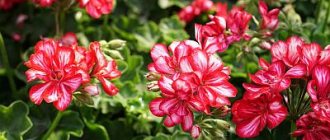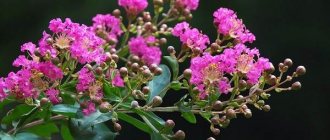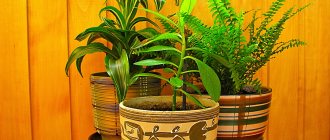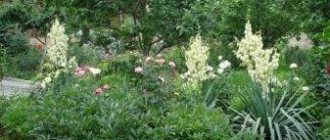Botanical name: Lemon (Citrus limon). Genus Citrus, Rutaceae family.
Homeland of lemon: India.
Lighting: light-loving, shade-tolerant.
Soil: slightly acidic, loose, nutritious.
Watering: moderate.
Maximum tree height: 9 m.
Average life expectancy: 60 years or more.
Planting: seeds, cuttings, layering, grafting.
What a lemon tree looks like: photos of flowers and leaves
Lemon is an evergreen tree up to 9 m high. The crown is wide, spreading, pyramidal, densely leafed, with numerous branches.
The trunk is straight, with light gray, fissured bark. The bark on perennial branches is reddish or reddish-violet, smooth, on annual shoots it is green. The bark of some varieties of lemons has small thorns.
The leaves are oval, simple, alternate, shiny, leathery, entire, with clearly defined veins, up to 15 cm long and 8 cm wide. Dark green, glossy above, light green, matte below. They are attached to a winged or wingless petiole 1.5-2 cm long. Lemon leaves have a pronounced citrus smell. Change every 2-3 years. They crumble gradually as they age. They contain a large amount of essential oils and nutrients necessary for the full development of the fetus.
You can see what lemon leaves look like in the following photo:
Lemon flowers are large, 4-5 cm in diameter, white or cream, fragrant, with a purple, five-membered corolla. Located in the leaf axils in pairs or singly. The bud develops in about 4-5 weeks. Lemon flower has a subtle pleasant aroma. The tree blooms at different times of the year, but the main flowering occurs in April-May and lasts for 7-9 weeks.
Lemon flowers are shown in the photo below:
What is the fruit, bush and taste of lemon?
The fruits are elongated-oval, with a growth at the apex, up to 10 cm long, up to 6 cm in diameter, narrowed at both ends, weighing 200-400 g. The peel is light yellow or bright yellow, with a tuberous crust. The pulp is greenish-yellow or deep yellow, tender, juicy, sour, consists of 8-10 lobes. Inside there are seeds that are ovoid, white or yellowish in color. Ripe fruits do not fall off, stay on the tree for a long time (up to 2 years), after which they begin to turn green and increase in size, then turn yellow again, while their taste deteriorates. Ripening in September-October.
An adult lemon plant produces an annual, abundant harvest. In warm climates it bears fruit throughout the year. The period of active fruiting is observed at 20-50 years of age. Fruits are formed mainly on last year's growths.
The lemon tree can be seen in the photo below:
Contraindications
Lemon is contraindicated if:
- there is an individual intolerance of the body;
- children under 3 years of age;
- allergy;
- ulcer of the duodenum or stomach;
- gastritis;
- pancreatitis;
- liver dysfunction;
- breast-feeding.
Lemon tree - caring for a houseplant
Attention! To avoid harm and preserve tooth enamel, drink lemon juice diluted through a straw. It wouldn't hurt to rinse your tongue and mouth.
Homeland and where the largest lemon in the world grows
The homeland of lemon is the subtropics and tropics of India, China and Burma, where the tree still grows wild in mountainous areas. According to botanists, the wild lemon was the result of cross-pollination between the lime and another citrus plant, estrog.
In countries where lemons grow, a hot tropical climate with high air humidity prevails. Today, citrus is grown in Central Asia, the USA, the Mediterranean, Moldova, on the Black Sea coast of the Caucasus, and Azerbaijan. In Russia it is used as an indoor plant.
When describing lemon, it should be noted that the plant is demanding of heat and light, but can also grow in shaded areas. Prefers loose, slightly acidic, nutritious soils with a neutral reaction. In drafts it drops leaves. Frost resistance is low.
The fruit pulp contains large quantities of citric, ascorbic, malic acid, sugars (2-3%), glucose (1-1.3%), fructose (1%), sucrose (1.2%), pectins, vitamins A, B, B2 ,C, coumarins, galacturonic acid. 90% of the pulp consists of water. The seeds contain fatty oils and a bitter substance – limonin. The branches and leaves also contain fatty oils. The leaves are rich in vitamin C. The bark contains the glycoside citronin. All parts contain essential oil.
It has been proven that lemon contains 2.5 times less sugar than grapefruit, 3 times less than orange and 4 times less than tangerine. However, it contains the highest amount of vitamin C of any citrus fruit. 100 g of pulp contains 40 mg of ascorbic acid.
Plant Formation
By trimming the shoots, you can shape the lemon into a suitable shape.
There are 3 main styles of shaping citrus fruits:
- free (bush);
- arrangement of branches on a trellis or near a wall (especially popular in countries with subtropical climates, where citrus trees grow in the ground);
- formation of a “tree” with a compact, loose crown – spherical, bonsai, etc.
Formation should begin with a young plant to avoid heavy pruning later.
Thanks to pruning, the plant is given the desired shape. Growing a lemon tree on a long trunk is not difficult. The young plant should be supported by tying the main shoot to a peg and pointing it vertically upward.
All existing and later appearing lateral branches are removed. When the main sprout reaches the appropriate height, its young, still soft tip is torn off. This will stimulate the growth of side shoots at the top of the stem. Due to repeated pruning of side shoots, a dense, well-branched crown is formed over time.
Citrus plants grow easily because they tolerate even heavy pruning. The shape with a spherical crown is a real work of art. On sale, such trees (depending on the variety) are more expensive due to their attractive appearance.
In the future, you need to shorten the shoots and systematically trim those that thicken the crown. If this is not done, the plant will lose its normal appearance and will be more difficult to reproduce later.
The shape of the tree may change due to the loading of the branches with large ripe fruits. The branches bend down under the weight of the fruit; you can help the plant by supporting it.
The use of lemon in folk medicine
Since ancient times, lemon has been used in folk medicine. Due to its high content of ascorbic acid, it is recommended as a prophylactic against colds. The fruit improves appetite, cleanses the body of toxins, accelerates wound healing, improves metabolism, and reduces cholesterol levels in the blood. The juice of this citrus is used to treat tonsillitis, atherosclerosis, rheumatism, gout, and is used for disorders of the gastrointestinal tract, vitamin deficiencies and mineral balance disorders. Scurvy is treated with citric acid.
Lemon is recognized as one of the most effective natural solvents and detoxifiers. Dissolves harmful substances in the body and promotes its rapid recovery.
The taste of lemon is very sour, but despite this, its juice neutralizes the increased acidity of gastric juice.
Fresh peel, eaten in small quantities, suppresses gas formation, improves digestion, is a good antiseptic and blood and intestinal purifier.
The citrus aroma improves your mood and invigorates, so it is recommended to drink a glass of lemon juice in the morning after waking up.
In modern pharmaceuticals, lemon extract, oil and juice are added to various medicines as a natural flavoring. Its leaves, which contain several times more vitamin C than the fruit, are also used in medicine. A decoction of the leaves has an antipyretic and analgesic effect.
Diseases, problems, pests and treatment
The lemon tree can suffer from improper care. Overwatering, dry air and restlessness of the tree can lead not only to loss of decorativeness, but also to the death of the plant.
Violation of maintenance rules often leads to the appearance of fungal diseases (sooty fungus, root rot, scab, warts). It will take a long time to treat the tree for these ailments, providing additional care and treatment with fungicides.
Injuries to the bark during pruning can cause infection with an infectious disease called gommosis or gum disease. In this case, you will have to treat damaged, oozing wounds by regularly treating them with antiseptic drugs and cauterizing them with garden pitch. To avoid this disease, all cuts, breaks and damage should be immediately treated with crushed activated carbon.
Despite the abundance of essential oils in the lemon tree, it is very tasty for parasites. Garden slugs, aphids, mealybugs, nematodes and spider mites are very fond of lemon. They can be expelled with commercial insecticides and home remedies, such as tinctures of onion, tobacco, garlic or liquid soap solutions.
Using lemon essential oil for hair
Lemon essential oil is widely used in cosmetology, which is a light yellow or light green liquid with a specific bitter or refreshing citrus smell. During prolonged storage it turns brown. Lemon oil is obtained from the fresh peel, flowers, leaves and bark of this plant by cold pressing or distillation. It can be used to whiten the skin, remove age spots and freckles. Lemon essential oil is included in moisturizing, softening and anti-aging skin care products, is used to heal wounds, strengthen nails, and is also used for oral care (it is enough to add 1 drop to toothpaste during brushing). As a result, gum inflammation disappears and teeth become whiter. It is used to care for skin that has lost its elasticity, aging skin, and also in the fight against cellulite.
Lemon oil is also used for hair. In order to give smoothness and shine to your hair, it is enough to add a few drops of oil to the water when rinsing it. The result appears after the first application. You can strengthen your hair and make it manageable in the following way: after washing your hair, just apply a few drops of oil to a comb and distribute evenly throughout your hair.
Essential oil is not used in its pure form, but is added to mixtures with vegetable oils, natural creams and other cosmetics. In its pure form, this oil serves only to treat herpes on the lips and various skin rashes. To do this, apply a small amount to the problem area without affecting the surrounding skin.
The fruits are eaten fresh and are also used in the production of confectionery, juices and alcoholic beverages.
In furniture production, carpentry and turning, lemon wood, which has a pale yellow or light brown tint, is valued. It has a beautiful structure with shiny spots, density and ease of processing. Products made from it have an ocher-yellow color, and when varnished they acquire an amber tint.
Lemon is grown not only as a fruit tree, but also as a flower and ornamental crop. Today, many varieties of this plant have been developed, differing in fertility, size and quality of fruits.
The following varieties grow and bear fruit well in indoor conditions:
Kinds
Among the most popular types we name:
- Meyer lemon with fast-ripening fruits;
- Ponderosa, characterized by large, tasty lemons;
- Pavlovsky is the most famous and most widespread, bred specifically as a houseplant. Can bear fruit all year round;
- New Georgian lemon has a strong aroma of flowers, and its fruits have no seeds;
- Genoa (Zhenoa) and Maykopsky are among the most productive varieties.
In addition to the usual ones, there are exotic varieties with fruits of unusual shape: for example, Lunario, which blooms on the new moon and has elongated pointed fruits, or the absolutely amazing variety Buddha's Hand , the fruits of which resemble a hand with outstretched fingers, but are inedible.
Photo gallery
A lemon bush at home reaches from 60 cm to 2 m in height.
Everyone knows what a lemon looks like, since this fruit is the most common of those found on store shelves. However, not everyone knows what type of edible lemon fruit is, because all fruits brought from tropical countries are yellow in color. Ripe and unripe citrus are distinguished by the shine of their peel. Thus, an unripe fruit has a matte skin, while the skin of a ripe fruit is shiny. A ripe fruit is hard and elastic, while softness indicates its overripeness.
High-quality lemons do not have dark spots or signs of damage on the surface. Brown spots on the peel indicate hypothermia of the citrus. It is not recommended to buy such a fruit, since when hypothermic, lemon loses vitamins and nutrients. Its pulp acquires a bitter taste. You can also buy unripe fruit, then it will be stored longer.
When choosing a lemon, you should know that thick-skinned fruits contain more vitamins than thin-skinned citrus fruits.
Fruits can be stored either in a cool place or at room temperature. To store in the refrigerator, lemons are placed in a container. The shelf life will be 1 month.
To store at room temperature, wrap them in parchment paper and put them in a dark place. Whole, undamaged fruit will keep for 14 days.
Despite the many beneficial properties, there are some restrictions on eating lemon. It is not recommended to consume it in large quantities, as this leads to the destruction of tooth enamel. In addition, citrus is a strong allergen, so it should be introduced into the diet with caution.
The pulp contains many organic acids, so if you have diseases of the liver, stomach or intestines, you should refrain from consuming this product.
Beneficial features
Lemon tree - how lemon grows and blooms
Lemon is considered a source of valuable minerals and vitamins. Used in cooking. English lemon jam has a sour taste and a delicate consistency.
Medicine cannot do without it. Essential lemon oil has an antibacterial and wound-healing effect. It is indispensable in the following cases:
- stopping bleeding;
- elimination of headaches;
- positive impact on the psyche;
- resolution of dermatological problems;
- removal of toxins;
- cleansing the kidneys and liver;
- prevention of neoplasms;
- strengthening blood vessels and heart;
- excess weight loss;
- normalization of metabolism.
Lemon is very useful
Traditional medicine notes the benefits of lemon for diarrhea and vomiting. In the treatment of snake bites, one could not do without lemon.
History of lemon
The history of lemon goes back to ancient times. This crop was first mentioned in the 12th century, but in China the plant was grown around 2000 BC. Since ancient times, people have used it for medicinal purposes. So, to invigorate the spirit and body, a composition was made from lemon and garlic. The recipe for this healing drink was developed by ancient sages especially for Pharaoh Mikeren, who lived 63 years and died of natural causes, which was very rare in those days.
In ancient medicine, lemon was used for intestinal disorders and fever. Decoctions were made from its fruits, which served to wash the stomach. To prevent cholera and jaundice, the fruit was added to many dishes.
Among the ancient Greeks, lemon became the emblem of marriages, and in Ancient Babylon, Jews brought the fruits of this plant on the day of hay veneration.
In the Middle Ages, lemon juice was used as an anthelmintic, and in the Renaissance, as a remedy against the plague.
In the 18th century Citrus fruits were considered the most effective against scurvy, so sailors took them with them on voyages.
At the end of the 18th century. Lemon began to be cultivated in Georgia. Later, the plant was brought to Tajikistan, where it was grown in open trenches. One tree in such conditions bore about 500 fruits per year. Today, the largest plantations of lemon trees are located in Italy on the island of Sicily.
In Russia, this culture appeared in the second half of the 17th century. The plant was brought from Holland to Moscow and planted in the Kremlin “rangery chambers”. In the 18th century Citrus began to be planted on landowners' estates for decorative purposes and to produce fruit. Lemon was grown at home from a seed. 10-20 fruits were obtained from one bush. This tradition is still maintained today. For example, in the city of Pavlovo, Nizhny Novgorod region, it is customary to grow 3-5 lemon trees at home.
The name lemon supposedly comes from the Malay word "le-mo" or the Chinese "li-mung", which means "good for mothers".
Lemons were brought to Europe from India by the soldiers of Alexander the Great. Before this, this fruit was unknown here.
In Africa, natural lemon juice is used as medicine. When consumed, squeeze directly into the mouth.
In Russia in the Middle Ages, this citrus was inaccessible to the common man. Its fruits were imported from Holland and served to the tables of rich people.
The largest lemon in the world weighs 5.265 kg. This figure was registered in the Guinness Book of Records in 2003. An Israeli farmer grew it on his plot.
In Spanish folklore, this fruit is considered a symbol of unrequited love.
The lemon plant can be seen in the photo in the gallery:











